Home » Open Learning
Category Archives: Open Learning
Student Perspectives on the Promising Practices for Teaching International Students
In our 2022 IGI-Global book, Handbook of Research on Teaching Strategies for Culturally and Linguistically Diverse Students, we explored the promising practices for teaching linguistically and culturally diverse international students by providing the student voice on such topics as culturally responsive education, pedagogy internationalization, teaching about academic integrity, student development and support, and online teaching and learning.
In our foundational work, we conducted a mixed methods study that reviewed the promising teaching practices to teach international students by evaluating the rate of student-satisfaction levels and perceptions of learning (Smith et al., 2019). The research design included a pilot study, an online survey questionnaire, focus-group discussions, and individual interviews. Research participants, with a response rate of 32 percent, were international students who studied at a mid-sized, comprehensive, public university in Canada. The primary research question is: What promising teaching practices yield high levels of international student satisfaction and perceptions of learning?
It was guided by three theories (Figure 1). The primary theory used is Tinto’s (1993) student integration model, which states that students must integrate into both social and academic settings, formally and informally, to create a connection with their postsecondary institution, resulting in them making a commitment to careers and educational goals. The researchers also relied on the work of Darby and Lang (2019), which highlights the connection between instructor personality and learning, and Tran’s (2020) framework for teaching and learning for international students, which underlines the importance of connecting with academic and social experiences.
Figure 1. Identifying Effective Teaching Practices (Smith et al., 2019)

Promising teaching practices received from respondents, that were reported as satisfied or very satisfied, varied from 49.7% to 82.9%. The teaching practices with the highest respondent satisfaction percentages (greater than 70%) fell into eight areas (Figure 2): academic integrity, assessment, assignments, clarifying expectations, communicating outside of the classroom, lecture design and delivery, verbal communications, and visual communications. All the promising teaching practices identified as having high levels of student satisfaction also have medium or high student perception levels of learning.
Figure 2. The Top Eight Promising Teaching Practices (Smith et al., 2019)

In the focus group and interviews (Figure 3), students’ responses were mainly positive. Most of them identified instructors as a key factor in the learning experience. Some characteristics (e.g., humour, encouragement and support, and the value of diverse cultures) were welcomed by students. Many practices were endorsed by students of all educational levels, including a student-centred approach, the use of interactive teaching methods, specific and prompt feedback, the use of practical experiences, a pleasant learning environment, and methods to support additional language learners. Undergraduate participants were interested in academic support, updated curricula, and partially filled slides in advance of class. They also emphasized the importance of experiential and applied learning, and close interaction with instructors. Graduate students spoke of the importance of a free learning environment, multi-modality teaching strategies, the use of digital and visual materials, and emotional, physical, and non-judgmental support from their supervisors. Teaching methods that led to students becoming bored and having heavy workloads, such as grammar-intensive teaching, and the use of the repeating-listening pattern of teaching and learning, along with a lack of encouragement, received dissatisfaction from students. There are some differences between course-based and research-based graduate student responses. Course-based graduate students commented on their course instructors and teaching methods, while research-based graduate students mostly commented on their relationship with supervisors.
Figure 3. Teaching practices that contribute the most to learning (Smith et al., 2019)

This study identified teaching practices that result in both student satisfaction and student perceptions of learning. Many students called for a multi-modal teaching style that combined traditional lectures and interactive methods. They also described some instructor characteristics as important factors in the student experience. Our research study found that the most promising teaching practices identified as having high levels of student satisfaction also have medium/high student perceptions of learning.
We are continuing our work through the creation of an online teaching international students website (https://teachintlstud.com/) that includes a professional development toolkit, resources for teachers, a professional community of practice, and a blog on teaching culturally and linguistically diverse students.
-Clayton Smith and George Zhou
REFERENCES
Darby, F., and Lang, J. (2019). Small teaching online. John Wiley & Sons.
Smith, C., Zhou, G., Potter, M., and Wang, D. (2019). Connecting best practices for teaching linguistically and culturally diverse international students with international student satisfaction and student perceptions of student learning. Advances in Global Education and Research, 3, 252-265. 24
Tinto, V. (1993). Leaving college: Rethinking the causes and cures of student attrition. University of Chicago Press.
Tran, L. T. (2020). Teaching and engaging international students: People-to-people connections and people-to-people empathy. Journal of International Students, 10(3), xii-xvii. https://doi.org/10.32674/jis.v10i3.2005
For more details on this study, see: Smith, C., & Zhou, G. (2022). Teaching culturally and linguistically diverse international students: Connections between promising teaching practices and student satisfaction. In C. Smith & G. Zhou (Eds.), Handbook of research on teaching strategies for culturally and linguistically diverse international students (pp. 1-16). IGI-Global.
SEM and Systems Thinking
Christine Kerlin (2008) wrote that “Enrolment management is a comprehensive and coordinated process that enables a college or university to identify enrolment goals that are allied with its mission, its strategic plan, its environment, and its resources, and to reach those goals through effective integration of administrative processes, student services, curriculum planning and market analysis” (p.11). It is a holistic process that plays out across the student learning journey from inquiry to graduation. And its fundamental premise is that we must look at our enrolment health and sustainability throughout the entire student experience as we link, integrate, and extend enrolment management across our campuses.
Each of us has a role in developing and sustaining the SEM ecosystem on campus. We need to engage in shared responsibility. If SEM reflects institutional identity and culture, it becomes an institution-wide strategy owned by each member of the community. This is best achieved through lateral communication where open and frequent communication becomes part of the culture. Hossler, Bean, and associates (1990) said it well when they wrote “The more people involved in decision making, the greater the commitment to implementing the decision” (p. 35).
One of the best ways to do this is to adopt a systems thinking approach. Peter Senge (2006) described systems thinking as “…a discipline for seeing wholeness rather than parts, for seeing patterns of change rather than static snapshots, and for understanding the subtle interconnectedness that gives living systems their unique character” (pp. 68-60). Systems thinking allows SEM practitioners to create a fully embedded enrolment management system that engages campus leadership, faculty, the SEM steering committee, and operational working groups. We have long known that enhanced integration and participation of all key campus stakeholders is a necessary pathway to achieving enrolment management effectiveness on our campuses (Smith, 2000).
If you want to learn more about SEM and systems thinking, consider joining me for the “Systems Thinking is the Key to SEM Success” pre-conference workshop at this year’s SEMM Forum in Toronto on Tuesday, November 7th, from 9:00 a.m. to 12:00 p.m, at the Mariott Downtown at Toronto Eaton Centre. In this workshop, participants will learn and discuss the basics of systems thinking and how institutions can introduce and support the implementation of an enrolment management ecosystem.
-Clayton Smith
References:
Hossler, D., Bean, J. & Associates (1990). The strategic management of college enrollments. Jossey-Bass.
Kerlin, C. (2008). A community college roadmap for the enrollment management journey. College and University, 83(4), 10-14.
Senge, P. M. (2006). The fifth discipline: The art and practice of the learning organization. Doubleday. https://www.seeing-everything-in-a-new-way.com/uploads/2/8/5/1/28516163/peter-senge-the-fifth-discipline.pdf
Smith, C. (2000). The perceptions of college and university enrollment managers on the relationship between institutional enrollment performance and enrollment management effectiveness. College and University, 76(1), 15-19. https://doi.org/10.2190/DJCF-Q6MB-35AV-EBW
Canadian Post-secondary Enrolment Trends
Recently, Stefanie Ivan, an enrolment management consultant and Royal Roads associate faculty, and I had an opportunity to identify enrolment trends facing Canadian higher educational institutions for a series of Royal Roads University webinars. In this blog, I will share what we found.
Let me describe our methods. First, we reviewed publicly-available data on the web that included provincial data reports as well as those compiled by Higher Education Strategy Associates, Globe and Mail, Statistics Canada, Canadian Undergraduate Survey Consortium, and the Council of Ministers of Education. Second, we collected comments from our social media network and Canadian colleagues. Third, we received input from students currently enrolled in the Royal Roads University Graduate Certificate in Strategic Enrolment Management.
Here are some of the aggregate enrolment trends we uncovered:
- College enrolments are continuing to grow, mostly due to continued international student enrolment growth. Some declines were reported in the Maritimes. Also, there is a reduction in demand for trades programming due to low unemployment.
- University enrolment is mostly stable or recording slight increases/decreases. Some of this is due to part-time student enrolment increases.
- Students may be shifting away from big urban research universities.
- A slight increase in inter-provincial mobility was experienced in the Maritimes.
- Admission conversion rates are becoming less predictable.
- Completion rates have been impacted in some areas.
- There is a growing interest in a gap year for direct-entry high school students.
And here are the student-type enrolment trends we found:
- Indigenous enrolment and completion rates are lower than rates for non-Indigenous persons. But the Indigenous birthrate is still the fastest among the groups monitored.
- International student enrolments continue to lead enrolment growth.
- Attrition rates are still impacted by the pandemic and high school students who did not seem to be prepared for post-secondary studies.
- The enrolment mix continues to change. Visible minorities, learners with disabilities, and learners with mental health issues are increasing.
- Students want to be primarily on campus, with some hybrid instruction.
- Trust building with communities continues to impact some enrolment.
Here is the Video from the webinar.
We will be doing a follow-up webinar to explore the enrolment strategies that institutions are using to address these challenges. Feel free to share any strategies your institution is using or hoping to implement in the next year, and we will include them when we present on this topic for our follow-up webinar on Tuesday, March 21st. Here is a link to sign-up if you want to listen in or (hopefully!) participate in our discussion.
The times are certainly uncertain and changing.
-Clayton Smith
Professor SEM
My higher education career has been all about Strategic Enrolment Management or SEM. From the beginning to now (and more to come!), I have learned about SEM, implemented SEM, and taught others about SEM. So, from being a practitioner, practitioner-scholar, and now a scholar, SEM has been at the centre of my professional life. Normally, I would not write about such things, but I couldn’t resist. It is my own way of starting off 2023 with a smile and a sense of pride.
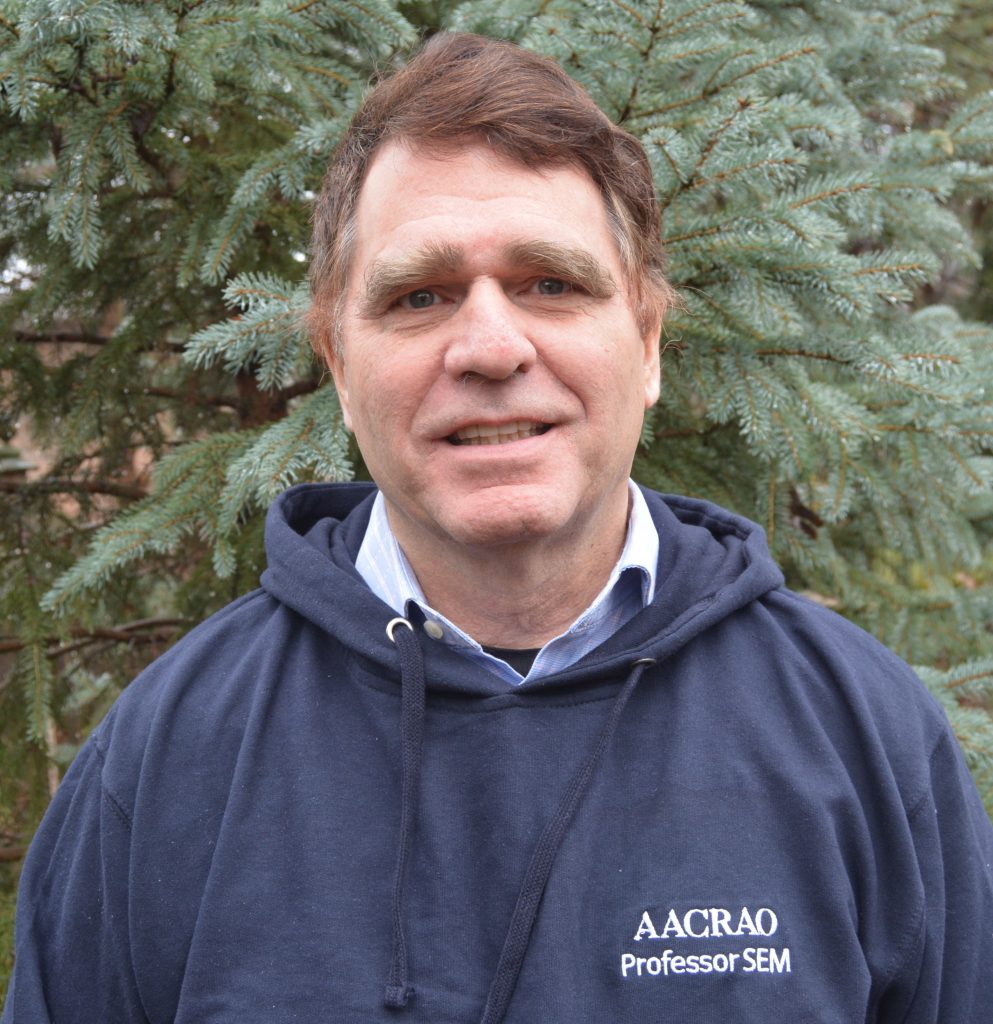
Following a six-year run as director of the American Association of Collegiate Registrars and Admissions Officers (AACRAO) SEM Conference, Melanie Gottleib, AACRAO’s executive director, provided me with a special gift during our Toronto conference. It is a hooded sweatshirt with just three words imprinted on it, “AACRAO Professor SEM.” It fit 2022 perfectly with my promotion to professor last summer, being named editor-in-chief of Strategic Enrollment Management Quarterly, and the publication of the AACRAO book, “The Effectiveness of SEM in Canada: Reflections from the Field,” with long-time writing colleague Susan Gottheil. I will cherish it always!
Before rambling on, let me thank the many colleagues at AACRAO and my home institutions (the University of Maine at Augusta, Tallahassee Community College, State University of New York College of Agriculture and Technology at Cobleskill, and the University of Windsor) who provided me with so much support over the years. Let me also thank the folks at Royal Roads University who allowed me to bring forward an idea we have been talking about in Canada for a long time; namely, the new Graduate Certificate in SEM (a shameless plug!).
Some of you may be wondering what this SEM thing is all about. Well, let me share a few thoughts.
While there are many definitions of SEM, the one penned by Hossler and Bean (1990, 5) is commonly embraced by the SEM community:
[Enrolment] management can be defined as an organizational concept and a set of systematic activities designed to enable educational institutions to exert more influence over their student [enrolments]. Organized by institutional research, [enrolment] management activities concern student college choice, transition to college, student attrition and retention, and student outcomes.
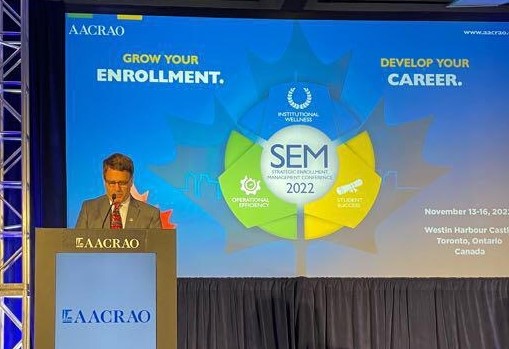
Subsequent writers have incorporated these words into their SEM definition: concepts and processes, institutional mission, and students’ educational goals (Bontrager, 2004); comprehensive process and academic contest (Dolence, 1993); comprehensive and coordinated process, and integration (Kerlin, 2008). The fundamental premise of SEM is that we must look at our enrolment health and sustainability throughout the entire student experience. Today, SEM has evolved to being a strategic component of institutional planning, resulting in:
- Instructional programs and services designed with intentionality, purpose, integration of effort, service efficiency, and positive interventions with students
- Integrated cross-campus collaborations and partnerships between faculty, administrators, and staff
- Use of assessment information-driven decision making
- Understanding how campus cultures impact enrolment management efforts
- Importance of shared leadership at multiple levels
Let’s simplify. The Cheshire cat in Lewis Carroll’s Alice in Wonderland says, “If you don’t know where you are going, any road will take you there.” Yogi Berra, of New York Yankees fame, adds “If you don’t know where you are going, you might wind up someplace else.” And today, we have got some great places to go!
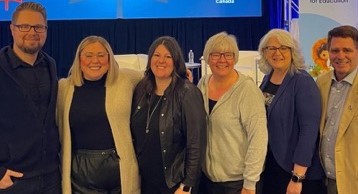
With my glass is half full approach, I can see some magical destinations. The first one is all about social justice. When we started doing SEM in the late 1970s, higher education was still a place where only some could go. Today, the door is open for many more, but not all. We need to put our collective heads together to ensure that our doors, both at the front end and at completion, are open to all who wish to continue their education. This includes Indigenous and racialized students, low-income and rural students, first-generation learners, and so many more. Second, we need to find ways to mature SEM into what many of us hoped it would become; namely, a managerial and educational framework. We are pretty much there with the former but have more distance to go to achieve the latter. SEM could be and should be a contributor to both of these goals.
Let me end with a passage from “The Effectiveness of SEM in Canada: Reflections from the Field” (2022, 53) that captures a possible future direction that the SEM community can traverse in the years ahead.
As the changing economy, politics, and student demographics have hit our institutions, it is ironic that we have been reluctant to explore difficult decisions and be truly strategic. Over the past few years, we have seen institutions of all types respond to these shifting pressures in similar ways–looking to international markets to replace domestic students, trying to rebrand and evolved into a different type of institution (changing from two-year to a four-year college, or an undergraduate into a graduate research institution), focusing on student retention. Can we use the SEM toolbox in new and innovative ways? We hope that the insights provided by SEM professionals across Canada will help higher education colleagues in institutions coast-to-coast build strategic plans that support students and institutions.
-Clayton Smith
References:
Bontrager , B. ( 2008 ). A definition and context for current SEM practice. In B. Bontrager (Ed.), SEM and institutional success: Integrating enrollment, finance, and student access. Association of Collegiate Registrars and Admissions Officers.
Dolence, M. G. (1993). Strategic enrollment management: A primer for campus administrators. American Association of Collegiate Registrars and Admissions Officers and Datatel.
Hossler, D., & Bean, J. P. (1990). The strategic management of college enrollments. Jossey-Bass.
Kerlin, C. (2008). Community college roadmap for the enrollment management journey. College and University, 83(4), 11.
University Degree v. University Education
In this blog, I share thoughts written by Shaun Smith, a recent University of Windsor graduate, on the differences between a university degree and a university education. It is inciteful and will likely result in some important reflections being made on the university student experience.
-Clayton Smith
Six years ago I sat in a large classroom surrounded by other recently-graduated high school students entering my program and listened to one presenter after another speak a variation of the same thing, “I wish I’d gotten involved sooner.” These presenters themselves were older students, about to leave university and go on either into the workforce or further education, and at the time, I couldn’t fully comprehend what exactly it was that they were attempting to say. One completed undergraduate degree later, when I was working with incoming high school students myself, I found myself telling them the same thing I had been told when I was in their position.
What these presenters by and large were saying as a collective was that they felt as though they had missed out on certain aspects of university life early in their time on campus. That their hesitation to reach back when the opportunities reached out had cost them in various personal, academic, and professional ways. It was only later, in their third or fourth years, did they fully take advantage of these opportunities.
Despite the advice of the presenters, my time in university began to play out in a very similar way. I was a commuter student, whose first-year mandatory classes were organized by my faculty to be in convenient windows of time (e.g. 8:30 AM-1 PM), which meant that outside of these windows, I perceived there to be little reason why I should remain on campus. Certainly, my fellow students also felt this way, as our faculty building was virtually deserted after 3 PM every day, when the final class had ended. As a true commuter student, I went to campus for class, and left as soon as I could. That pretty accurately describes the first two years of my undergraduate, I even studied at home, or with one or two of my classmates off-campus.
Said differently, I was in the process of earning a university degree. My grades were good, and I had worked hard enough in my second year that my name showed up on the Dean’s List for the first time. By any academic measure, I was well on track to graduation.
In third-year, however, something changed. Although I had a reasonably positive and fulfilling social life (primarily off-campus), the decision was made to make more of an effort on campus as well. I had always played intramural sports, but now I found myself hanging out with the people I knew there outside of the gym or soccer pitch, which opened up an entire community to me (who wound up becoming an incredible source of social support for me during the COVID-19 pandemic). I had always done due diligence in my classes, but when a professor asked if any of us were interested in competing in a case competition at another university, this time I thought, “why not?” instead of “that’s not for me.” Instead of leaving campus when my classes were completed, I began to actively look for things to do, which resulted in me doing everything from judging academic debates to participating in mental health initiatives for faculties that were not even my own. I went to buildings on campus I never had before through electives that I found genuinely fascinating, and unlike my first two years, actually made an effort to be a part of those groups instead of dipping upon the conclusion of the class. This, for the first time, actually opened up the entire university to me as opposed to just my own department.
I could go on, but for the sake of brevity, will instead summarize by saying that this was every day. My university experience went from a primarily class-based academically grounded experience to a socially diverse and entirely unpredictable day-to-day experience with people I perhaps had just met that morning, doing activities that the previous version of myself could not have possibly seen himself participating in.
Perhaps this sounds stressful. Perhaps it seems as though my academics would suffer, that this spontaneity where I departed my home every morning having no idea how the day would play out could only create harm towards the goal that every student has when they first come to university: the degree.
The complete opposite was true.
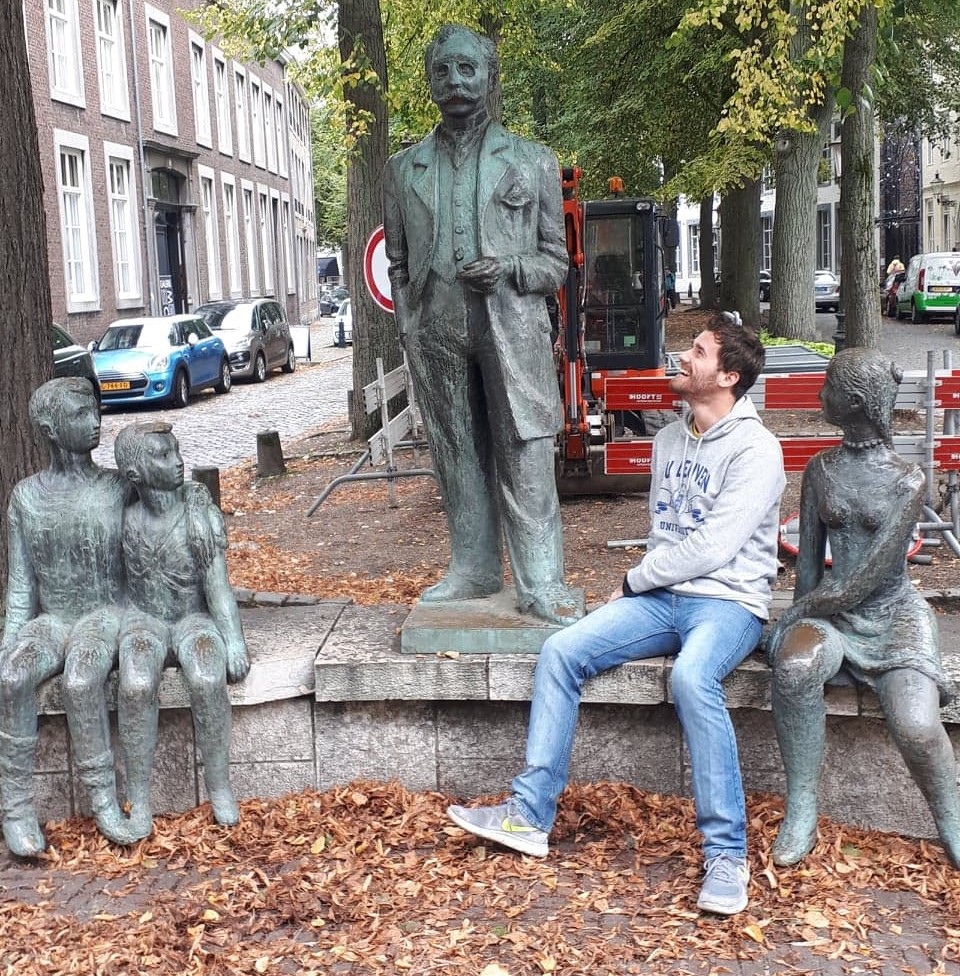
I became significantly happier. My grades skyrocketed. I went from being an above-average student to one of the best in my faculty. I made friends from every corner of campus, and because of the international nature of the university, every corner of the world. My professors not only learned my name, but began offering research opportunities and academic-related guidance that had always been there, but I hadn’t previously had the gumption to take advantage of. For the first time, I realized what those senior students had been trying to convey – that there is a significant difference between a university degree and a university education.
A university degree is something we all know. It’s a piece of paper that signifies that an individual has undergone an accepted curriculum and passed. But that’s all it is.
University education is something else entirely. Yes, it is everything that happens inside of the classroom, but more importantly, it’s everything that happens outside said classroom.
When I graduated from university, I had a collection of skills that I had learned there, but the vast majority of them I obtained from the education, not from the degree. The university degree taught me important skills: work ethic, consistency, specialized knowledge, and showing up. The university education taught me everything else.
When I took part in the “real world” this collection of skills proved invaluable. Interpersonal dynamics in particular have played a strong role, and the social environment of a diverse campus is the perfect place to cultivate such a skill. Of course, there are skills beyond that that has drastically improved everything from my overall adaptability in both professional and personal situations. Everything from my public speaking to my comfortability with challenging my own worldview has its root in my university education.
If this is still somewhat unclear, refer to the age-old conflict between intelligence and wisdom. If intelligence is the presence of knowledge, and wisdom is the ability to apply it, the university degree is the presence of knowledge in an individual, and the university education is the skills from which one can apply that knowledge most effectively.
Even as a student I became aware of all this. The question following my third year was how to maximize this education while I still was in the opportunity-laden university environment. For me, it resulted in my going on a student exchange to Belgium (something that I in my first-year would have been both impressed and terrified by) for my final undergraduate year. To say that it was stepping outside of my comfort zone is the understatement of the century, but it certainly maximized the university education aspect, and I look back on years three and four as the best of my life…so far.
Fast-forwarding to the current day, as I apply for positions and look to start what I hope is a long and successful professional career, I am often relying on my university education, and my prospective employers are too. No HR or management person has cared one bit what my GPA was, in fact, I’ve never been asked. However, they care very strongly about one’s ability to solve their problems, and very rarely is that solution specialized knowledge. It is instead one’s ability to problem solve complex and ever-evolving challenges and to be able to do so as part of some type of team.
My university degree prepared me only in part for that. My university education absolutely finished the job.
-Shaun Smith
Teaching Through the Screen
Earlier this week, during the virtual Fierce Education conference titled, Higher Education: Helping Faculty Navigate top Challenges in this New Blending Learning Environment, I had the opportunity to take in a talk presented by Sean Michael Morris, vice-president, academics at Course Hero. In his presentation, “Teaching through the Screen: Engaging Imagination to Engage Students,” Sean spoke about critical pedagogy as a humanizing pedagogy; that our focus should be on “seeking the human behind the screen, the human behind the bureaucracies of education, the human behind behaviorist technologies.” So, put another way, we should not teach to the screen (after all it is just a digital tool!), but look through it to those behind the screen who we are teaching. Only by changing our perception of online learning will we be truly able to engage our students. Wow, what a revelation!

Looking into the distance at the Cliffs of Moher, Ireland
Sean introduced us to Maxine Green who wrote in 2000 that “Our obligation today is to find ways of enabling the young to find their voices, to open their spaces, to reclaim their histories in all their variety and discontinuity” (Releasing the Imagination, 120). Imagination, as a “practice of freedom,” can inspire us to change the way we reach our learners. With the COVID-19 experience and our two-year pivot to online learning, this is more needed today than ever.
He then reminded us of what Jesse Stommel said about starting by trusting our students and emphasized that students are producers of knowledge, not just consumers of knowledge. Remembering that the more we know, the less we imagine, can be a powerful learning concept. Engaging students in a learning partnership is empowering for both learners and instructors. In a 2014 interview, Stommel commented:
Learning is always a risk. It means, quite literally, opening ourselves to new ideas, new ways of thinking. It means challenging to engage the world differently. It means taking a leap, which is always done better from a sturdy foundation. This foundation depends on trust – trust that the ground will not give way beneath us, trust for teachers, and trust for our fellow learners in a learning community.
-Jesse Stommel
So, what if we trusted our students as co-learners and used our imagination to see through the screen?
While this may have been true pre-pandemic, it is even more true now. The days of students coming to us to attend in-person classes in university lecture halls have probably changed. An increasing number of students will probably be seeking online courses, be they synchronous, asynchronous, or blended. They will be the new traditional learners in post-secondary or tertiary learning. We will need to trust them and encourage their learning by “seeking the human behind the screen.”
I am ready!
-Clayton Smith
The Changing Roles of Higher Education
After nearly two years of teaching exclusively online, I began teaching in person today. A little nervous but pumped regarding the prospect of seeing students in person again.
This led me to think about what kind of experience students will want in this near-to-the-end pandemic world we are entering. It was then that I came across an article, written by Dana Abdrasheva, Diana Morales, and Emma Sabazlieva, in University World News, an online newsletter, that led off with the title, How Do Students Want Universities to Change in Future?
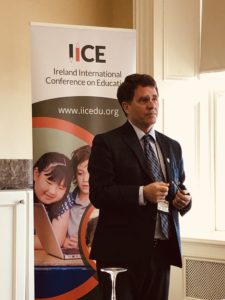
This article presented a summary of a UNESCO report, Thinking Higher and Beyond: Perspectives on the Futures of Higher Education to 2050, which presented the views of students from around the world who participated in one of 55 focus group consultations conducted in 2020-21 as part of UNESCO’s Futures of Higher Education project. Some of the themes identified include:
- Campus experience will be transformed: Campus experiences will be complemented (but not replaced) by integrating technology into teaching and learning.
- A shift from mobility to engagement: Recognized that “mobility will turn into connectivity” and that travelling to other countries might not be necessary to acquire an international educational degree.
- Co-creation of learning environments: “New forms of knowledge construction, based on cooperative and collaborative relationships between teachers-students and students-students” will result in more co-creation of learning.
- Higher education and the labour market: Links between higher education and the job market are of prime importance, with many calling for more “market-ready” preparation.
- Global processes linked to local communities: Connectivity is seen as the big takeawaywith calls for increased connections between global and local communities.
The big question is whether we, in higher education, are ready to attend to students’ views on the changing roles of higher education.
Throughout the pandemic, I can recall conversations with students who lamented about the loss of in-person instruction, while others asked for their courses to remain online. This led me to conclude that it is not one way or another, but looking at what is needed and then delivering the student experience as close to that vision as possible. This does not mean we will return fully in person, but neither does it mean we will stay fully online. We need to do what is best for our students, and in doing that, we will find a higher education experience where the campus experience is transformed, our focus is placed on engagement, we engage with our students as partners in learning, and connect our work with the labour market and global communities.
These are fascinating times!
-Clayton Smith
Beyond COVID: A SEM Perspective
There has been so much discussion about “getting back to normal” or creating “the new normal” during these pandemic times. What we know is that, with past pandemics, we have seen the upending of critical structures, such as health systems, economic life, socioeconomic class structures, and race relations. (De Witte, 2020). The impacts have included the way our institutions and communities operate, as well as how family members interact with one another. Today, I find myself wondering what the impact will be on post-secondary education and how it will adjust to whatever normal that may emerge following the COVID-19 experience.
A short time ago, I had the pleasure to convene a webinar panel discussion, Coming Out of COVID, in which four enrollment leaders from the U.S. and Canada shared their views on how post-secondary institutions will approach life after the pandemic. A common thought was the need to develop a sense of urgency on campus so that the pinnacles of SEM can be maintained (institutional wellness, operational efficiency, and student success). Some of what they said also touched on these topics:
- Communications, communications, and more communications
- Flexibility
- Finding the right balance between online and in-person student experiences
- Supporting the staff who serve at the student touch points
- Variable impact on different student populations, and that one process may not work for everyone
- Affordability, with many students left with financial challenges due to the pandemic
At the recent American Association of Collegiate Registrars and Admissions Officers Strategic Enrollment Management Conference (the first in-person conference I have attended in two years!), we heard from our keynote speakers on this topic. Here are a few highlights:

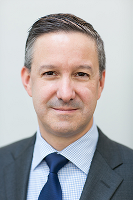
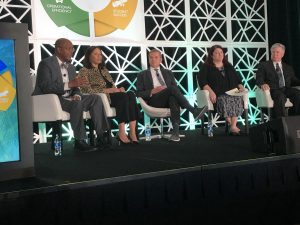
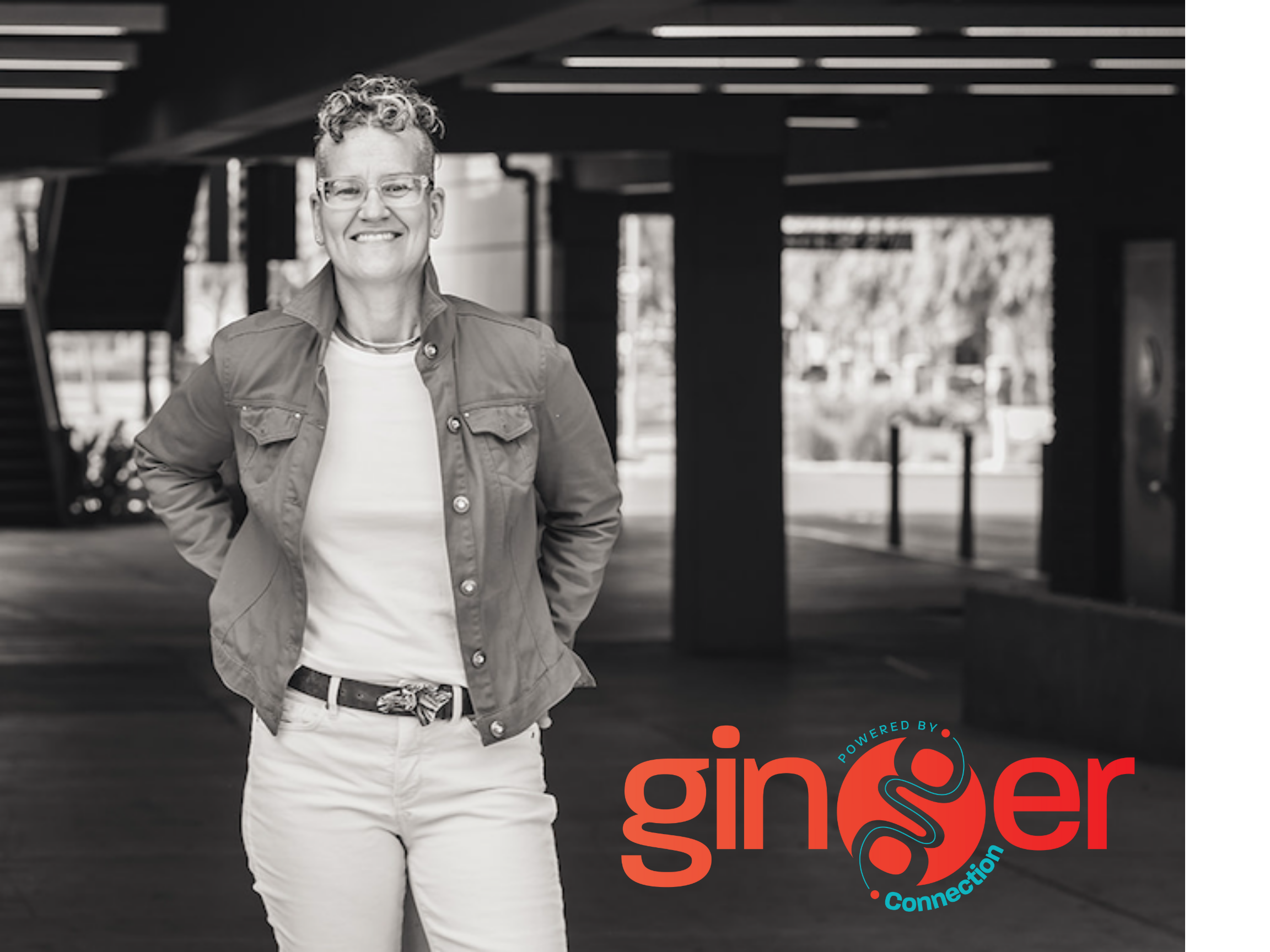
- Dr. Gregory Fowler, president of University of Maryland Global Campus, called on us to “improve end-to-end the student experience.” He challenged us to cultivate human skills, recognize that learning is everywhere, and educational institutions need to support the learning that people need across their lifetime.
- Jeff Selingo, author of two New York Times bestsellers , College (Un)Bound and There is Life After College, and the new book Who Gets in and Why: A Year Inside College Admissions (which he signed a copy for me!), described the student experience as about learning “how to negotiate relationships.”
- A higher education panel (Dr. Monica Parrish Trent, Achieving the Dream; Dr. Dhanfu Elson, Commplete College America; Dr. Kevin Pollock, Central Carolina Technical College; and Laura Clark, Virginia Community Colleges) spoke about the importance of supporting learning and student success across all student demographics, with a particular focus on those who start their post-secondary learning in community colleges.
- Ginger Johnson spoke about “At the Table of SEM,” we need to move from networking to connecting; that by connecting with each other, we can truly transform our learning organizations. Specifically, she called on us to 1) seek alignment as a way to transform our institutions and not just change them, 2) keep things simple by being productive while being “seen, valued, and heard,” and 3) support belonging by “always having time to connect” with one another. Ginger graciously left us with signed copies of her book, Connectivity Canon: Why and How to Connect with People on Purpose with a Service Mindset.
Pulling all of this together and reflecting on what our new normal will become, I find myself being optimistic regarding all the things we can do in higher education. It also makes me return to my teaching philosophy, Teaching for Learning, in which I describe education from the learner’s perspective; that our task is to create “educational environments that enhance learning and by engaging students individually in ways that inspire them.” This can best be done when we attend to the SEM trilogy of student success, institutional wellness, and operational efficiency while taking into account our takeaways from the pandemic.
I can hardly wait to see what we come up with!
-Clayton Smith
De Witte, M. (2020). Past pandemics redistributed income between the rich and poor, according to Stanford historian. Stanford News. https://news.stanford.edu/2020/04/30/pandemics-catalyze-social-economic-change/
Taking Time to Ponder
Harvard psychology professor Ellen Langer said something on this week’s Sunday Morning news show that caught my attention and put me on a reflective path.
Langer said that human beings are unique in their ability to think about the future, which leads us to be thinkers about our unique and collective futures (Weisfogel & Ross, 2020). While recognizing that plans create an illusion of control and that plans are guesses, these uncertain times call for us to contemplate and hope about what is to come. Langer goes on to say, “But what we need to recognize is that if something leads us in a different direction, that could end up even better for us.” So, in other words, by taking time to ponder, we each may be able to find a pathway toward a different but perhaps more enjoyable destination.
I thought about this all day.
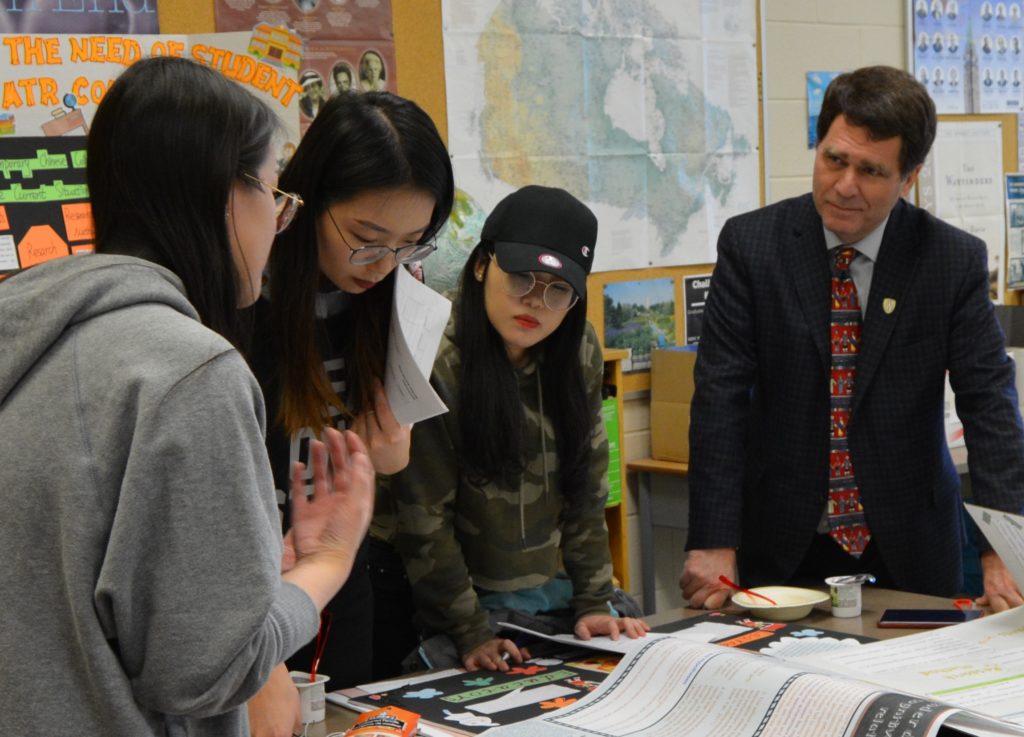
Since returning to teaching four years ago, I have focused my research in three areas. First, I have continued my career-long work in critically assessing the impact of Strategic Enrolment Management on the twin goals of achieving institutional health and student success. Second, I renewed my interest in the international student experience by exploring student perspectives on the way we teach in our colleges and universities and how we can improve our teaching of culturally and linguistically diverse international students. Third, after coauthoring two open educational resource (OER) textbooks and making increasing use of OERs in my teaching, I am beginning to focus on how we can achieve deep and interdisciplinary learning by enhancing our use of OERs.
While each of these research threads are different, it occurred to me that there is common ground between them; namely, the amplification of the student voice. If ever there was a time to pay more attention to student views, it is now. The COVID-19 Pandemic has left so many of us questioning the future. This includes students, faculty and staff, and those who lead our postsecondary educational institutions.
Psychiatrist Pavan Madan, who was also interviewed on Sunday Morning, spoke about the anxiety that is impacting us all. Dr. Madan suggests that “we put our big dreams aside for now and focus on the small, more manageable details of daily life” (Weisfogel & Ross, 2020).
So, in this public space, let me say that during the balance of the time we have in the Pandemic and for the time to follow, I will commit to amplifying the student voice in all I do.
If this interests you, consider joining me (Clayton.Smith@uwindsor.ca). I am thinking that both the journey and the destination will be quite enjoyable.
Clayton Smith
Weisfogel, A. & Ross, C. (27 December 2020). Going to Plan B: When COVID pulls the rug out from under you. Sunday Morning. New York: CBS. https://www.cbsnews.com/news/going-to-plan-b-when-covid-pulls-the-rug-out-from-under-you/?ftag=CNM-00-10aab8c&linkId=108041071
A Tale of Two Cities
Today, I find myself reflecting on Charles Dickens’ 1859 historical novel, A Tale of Two Cities, in which he tells the story of French doctor Alexandre Manette, released from the Bastille prison after an 18-year imprisonment, which was based on dubious charges. Dickens describes the conditions leading up to the French Revolution and the Revolution itself, that connects the arrogant behavior of the aristocracy to the revolutionaries’ political, social, and economic demands for justice. Dickens sets forth the idea that resurrection and transformation are both possible on personal level and societal levels.
In the opening sentence, Dickens writes:
It was the best of times, it was the worst of times, it was the age of wisdom, it was the age of foolishness, it was the epoch of belief, it was the epoch of incredulity, it was the season of Light, it was the season of Darkness, it was the spring of hope, it was the winter of despair, we had everything before us, we had nothing before us, we were all going direct to Heaven, we were all going direct the other way—in short, the period was so far like the present period, that some of its noisiest authorities insisted on its being received, for good or for evil, in the superlative degree of comparison only.
Much of what Dickens saw in the 19th century is reflected in our discussions today regarding the crises facing higher education in North America. Many of us continue to believe that through resurrection and transformation, we can change as individuals and as a society. What is increasingly clear is that we cannot go it alone. We will need to find ways to join together to improve and transform our individual post-secondary educational institutions and the system of higher education as a whole.
Let’s think on this within the context of the two major crises that are present in our world now.
As of today, according to the World Health Organization, there are 8,708,008 confirmed cases (nearly 30% in North America alone) and 462,715 deaths attributed to the COVID-19 pandemic, resulting from an infectious disease caused by a newly discovered coronavirus. Henry Chesbrough, Faculty Director of the Garwood Center for Corporate Innovation at the Haas School of Business at UC Berkeley, writes that the pandemic “is placing many universities under extreme budget pressure, owing to the loss of high-margin international students” (para 1) that may result in some campuses not opening in the fall and others further discounting tuition to students. Many other institutions have announced plans to offer online only or mostly online instruction. Taken together this will likely impact educational access and success for first generation, marginalized and low-income students.
On May 25th, George Floyd, a 46-year-old black man, was killed in Minneapolis by a white police officer, who knelt on Floyd’s neck for almost nine minutes while Floyd was handcuffed and lying face down, begging for his life and repeatedly saying “I can’t breathe.” (BBC, 2020) This has led to demonstrations in the U.S., Canada, and throughout the world against police brutality, police racism, and a lack of police accountability. Post-secondary leaders responded by issuing statements that “condemned the killing of Floyd and implored the community to seek out opportunities for kindness.” (Burke, 2020, para 1) Conversations and actions to address systematic racism will likely dominate discussions at North American campuses in the months and years to come.
The questions that are central to my reflection are these:
- What is the role enrollment management should play in responding to these crises?
- What can or will the enrollment management community do to address each of these crises?
- How will we position ourselves to be ready to help our institutions with future crises?
I believe that we are up to the tasks that lie ahead, but also believe it will take more than individual effort to make a difference. We will need to come together as colleagues and caring persons to face these challenges and respond to these important questions. Toward that end, our national association, the American Association of Collegiate Registrars and Admissions Officers, has decided to face these questions by convening the 2020 Strategic Enrollment Management Conference virtually and focus on the theme, “Crises as Catalysts for Transformation: 2020’s Impact on Higher Education and Enrollment.”
As the conference director, let me encourage you to submit a session, stop and share, poster, or roundtable proposal that highlights your experiences, best practices, and solutions. The Call for Proposals is now open. The proposal due date is July 31, 2020.
If I can be of any assistance, please write to me at smithc@aacrao.org.
-Clayton Smith

References
BBC News (May 30, 2020). George Floyd: What happened in the final moments of his life. https://www.bbc.com/news/world-us-canada-52861726
Burke, L. (June 1, 2020). College leaders respond to death of George Floyd. Inside Higher Ed. https://www.insidehighered.com/quicktakes/2020/06/01/college-leaders-respond-death-george-floyd
Dickens, C. & Schama, S. (1990). A tale of two cities, book the first, chapter 1. New York: Vintage Books.
Furber, M, Burch, Audra D. S., and Robles, F. (May 29, 2020). What happened in the chaotic moments before George Floyd died. The New York Times. https://www.nytimes.com/2020/05/29/us/derek-chauvin-george-floyd-worked-together.html
World Health Organization (June 21, 2020). WHO Coronavirus disease (COVID-19) dashboard. https://covid19.who.int/
Recent Comments